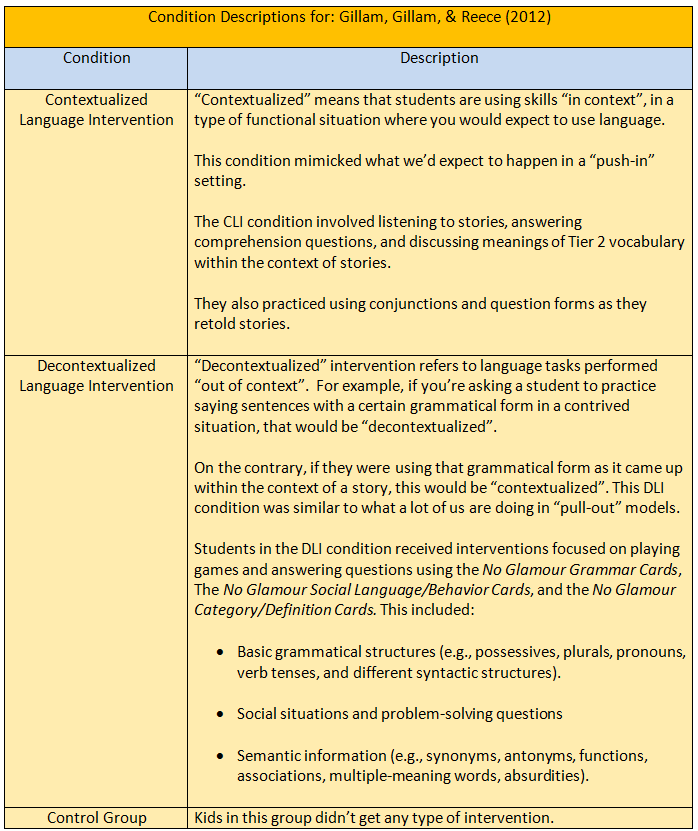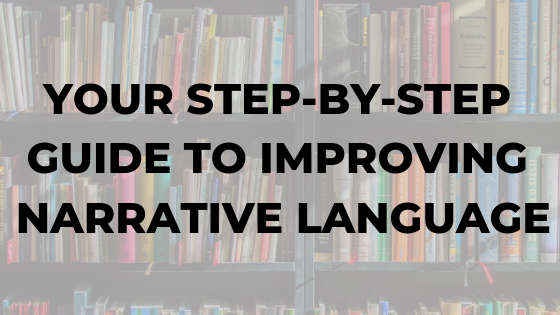Have you ever felt like you should be doing more “push-in” therapy instead of resorting to the standard “pull-out” model?
If you’ve ever felt this way…it’s okay to give yourself a break.
Why?
First of all, it’s probably not your fault. Scheduling can be a disaster. With the large caseloads we have, it can seem impossible to get in to the classroom.
Second, everyone keeps telling us we’ve got to be “pushing in”. Yet no one bothers to tell us what we’re supposed to be doing once we get in there.
That becomes a problem because if we don’t have a clear path, we end up floating around the room and becoming a “homework helper” and our therapy gets watered-down.
If you’ve ever encountered any of those problems, I want to solve them for you with this research summary and FREE narrative language protocol.
Both will help you boost your students’ narrative skills; whether you’re pushing in or not.
Here’s the citation for the study I’m going to outline that goes along with the protocol:
Gillam, S. L., Gillam, R.B., & Reece, K. (2012). Language outcomes of contextualized and decontextualized language intervention: Results of an early efficacy study. Language, Speech, and Hearing Services in Schools, 43, 276-291. doi:10.1044/0161-1461(2011/11-0022
First things first. Let’s talk about the study.
It should go without saying that one of the most powerful things you can do to help your students succeed in school and life is to improve their ability to tell (and retell) stories, which is why these researchers sought to answer the million dollar question we’re always asking ourselves:
When it comes to building narrative language, is it better to “push-in” or “pull-out”?
And if it is better to “push-in”, what the heck are we supposed to do when we get there?
Gillam et al compared the impact of the following on measures of narrative language, cohesion, and sentence structure: Contextualized Language Intervention (CLI), Decontextualized Language Intervention (DLI), a control condition.
If you’re wondering what that means, I’ve broken it down in plain English in the table below.
There were a total of 24 students in the study (divided across the three conditions: CLI, DLI, or control). They all had language impairments and were between 6 years, 0 months and 9 years, 0 months in age.
Over the course of a 6-week period, students in the DLI and CLI conditions got interventions focused on language and sentence structure for 50 minutes 3 times per week; while the control group didn’t receive any specialized instruction.
Here’s a breakdown of the three conditions in the study:

*For a step-by-step protocol of CLI for narratives, check out this FREE download.
Now let’s talk about the results.
The researchers compared performance before/after intervention using the following measures:
Clinical Evaluation of Language Fundamentals-4th Ed. (CELF-4) Recalling Sentences Subtest, Formulated Sentences Subtest
Test of Narrative Language (TNL): Narrative Language Index, Narrative Comprehension Subtest
Monitoring Indicators of Scholarly Language (MISL): Microstructure Subscale, Macrostructure Subscale
Gillam et al. found that the DLI and CLI groups outperformed the control condition; which shows that both types of intervention were better than doing nothing; so no surprises there. This is encouraging because it shows that both “in context” and “out of context” methods were effective in improving language skills.
There was also a significant improvement in language skills for both the DLI and CLI conditions from pretest to posttest, showing that the positive impact on narrative language skills was substantial for both interventions.
So now the moment of truth: Contextualized vs. Decontextualized
As expected, the CLI condition did significantly better than the DLI condition when the researchers made a comparison between the two.
This means that the intervention delivered “in context” (similar to what we’d expect in a “push-in” model) was more effective than focusing on discrete language skills “out of context” condition (more like what we might see in a “pull-out” setting).
What we can take away from this goes back to the mantra of “don’t drill and kill; drill and practice”.
It’s important to teach our students discrete skills of language if they’re lacking in those areas. But doing that alone is not enough. We need to then take that next step and give them the opportunity to use language in functional situations in order to get generalization.
This leaves a number of questions unanswered (like most research studies):
What are we supposed to do if we can’t get in to the classrooms to do push-in?
What if our students really need work on specific grammatical skills or vocabulary?
Does this mean that I should get rid of my “No Glamour” cards or other super convenient pre-made language activities?
So…how do I actually do CLI ?
I don’t want to leave you hanging, so I’ll answer each one of these questions and then give you this FREE printable narrative language protocol you can print and use right away, whether you go the “push-in” route, or whether you just want to try this with a “pull-out” model.
First…what if push-in is near impossible?
Does that mean we have to settle for less effective therapy?
Not necessarily. The CLI condition in the study involved activities that were more “classroom like” because it involved reading and storytelling.
It would be ideal if you could do these types of activities in the classroom, but there’s no reason you can’t do this type of activity in your therapy room as well.
In other words, if you can’t push-in; you can try to make your therapy room mimic the classroom as much as possible.
What if our students need specific work on specific language skills or vocabulary? Shouldn’t we do this first in a structured setting?
Yes, some of our students might need some practice in more structured situations first before we ask them to apply those skills. The results of this study focused on narrative discourse, so the measures the researchers used to gave information about cohesion and narrative language.
It’s possible that students in the DLI condition may have improved on certain discrete skills that the researchers didn’t measure.
Your best bet would be to make sure that if you start out with some type of “drill” or discrete skills activity, you make sure that you also target that skill within a more functional situation like the CLI condition once the student can complete the skill in a structured task.
Should I get rid of my pre-made activities and flashcards?
No! It’s okay keep all of those staples that help you save time. Just make sure you use them the right way.
I use my No-Glamour Cards all the time.
The key is to use these discrete and “decontextualized” tasks to practice or introduce skills, but then always be working towards “contextualized” practice and striving to do it both in your room and in the classroom.
Last, are you wondering how you actually do CLI for narrative language?
If so, I’ve laid it all out for you in this FREE downloadable narrative language protocol.
This protocol will work whether you’re doing all push-in, all pull-out, or a mix of both. If you are able to push-in, it will answer the daunting question of, “Now that I’m “pushing-in”, what am I supposed to be doing here?” You can get it here:


